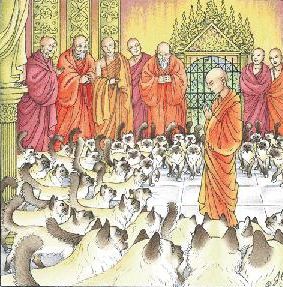Point coloration refers to animal coat coloration with a pale body and relatively darker extremities: face, ears, feet, tail, and (in males) scrotum. Colorpointed breeds occurs in certain species of rabbits, rats, sheep and horses, but most are found in the family of cats (Felidae) where it is a form of partial albinism resulting from a mutation in tyrosinase — an enzyme involved with melanin production. The mutated enzyme is thermolabile: it fails to work at normal body temperatures, but becomes active in cooler areas of the skin. As a result, dark pigment is limited to the coldest areas of the body, that is, the extremities. Pointed kittens are born white, since the womb is uniformly warm. As the kittens age, the cooler areas darken while warmer areas remain cream to white in color.
An example of a colorpointed cat is the Birman (also called the "Sacred Cat of Burma"), a domestic long-haired breed that is distinguished by a silky coat, deep blue eyes and contrasting white "gloves" or "socks" on each paw. The breed name is derived from Birmanie, the French name for Burma. Recognized point colors are seal, chocolate, blue and lilac (a softer silver-grey).
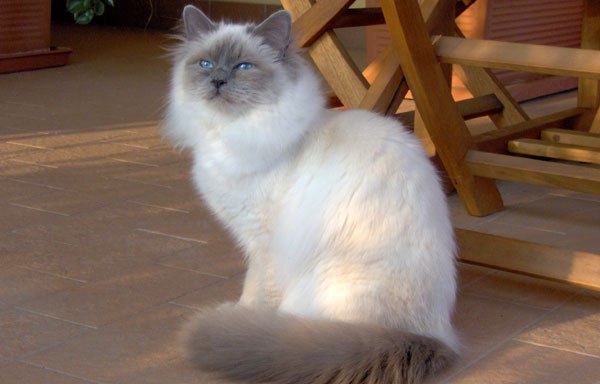
When breeding Birman pure-lines, it is essential to have some basic understanding of the genetics that determines what point colors the litter of a couple of cats may have. Each cat has two C-genes $$c_p$$ and $$c_m$$ where the first is paternal and the second is maternal in ancestry. In addition, each cat also has two D-genes $$c_p$$ and $$c_m$$ where again the first is paternal and the second is maternal in ancestry. The point color is completely determined by the combination of these four genes.
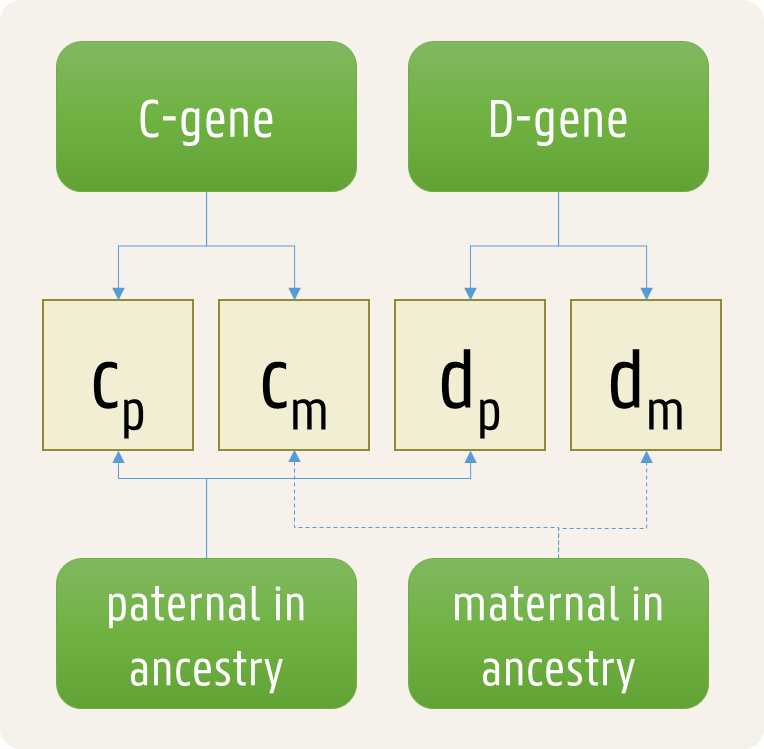
There are two alleles (alternative forms) of the C-gene that we will represent by the letters C and c, and two alleles of the D-genes that we will represent by the letters D and d. As a result, we can represent the cat's point coloration genotype by the string $$c_pc_md_pd_m$$, with $$c_p, c_m \in \{\texttt{C}, \texttt{c}\}$$ and $$d_p, d_m \in \{\texttt{D}, \texttt{d}\}$$. The relationship between the 16 possible genotypes of the C-genes and D-genes and the resulting point colors is given in the following color table, where we have used the abbreviation choc for the point color chocolate.
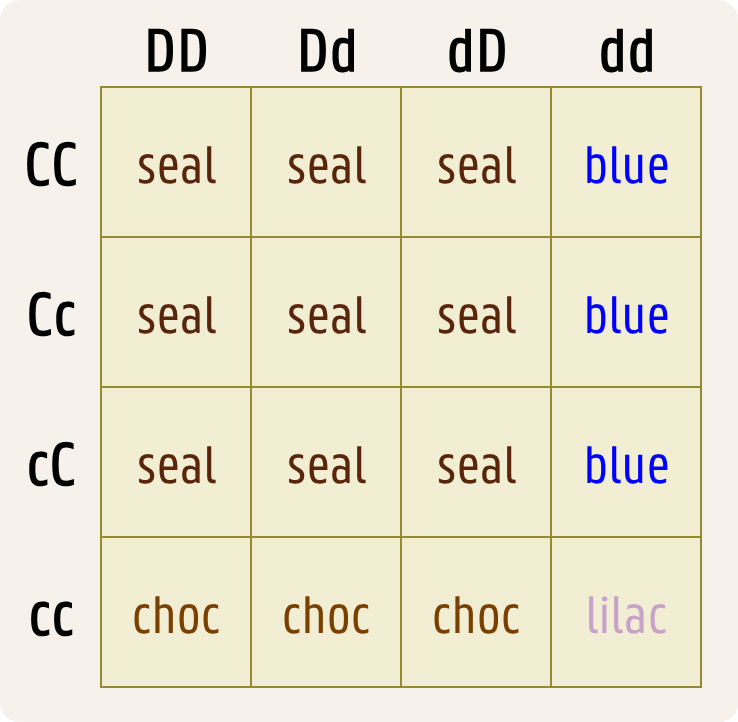
A Birman having genotype $$c_pc_md_pd_m$$ randomly passes one of its two C-genes ($$c_p$$ or $$c_m$$) and one of its two D-genes ($$d_p$$ or $$d_m$$) on to each of its kittens. In other words, the cat passes one of four possible combinations $$gh$$ of a C-gene $$g$$ and a D-gene $$h$$ on to each of its kittens, with $$g \in \{c_p, c_m\}$$ and $$h \in \{d_p, d_m\}$$. It is custom practice to fix a generic order of these four possible combinations in the following way: $$c_pd_p$$, $$c_pd_m$$, $$c_md_p$$ and $$c_md_m$$.

If a male Birman with genotype $$c_pc_md_pd_m$$ mates with a female Birman with genotype $$c'_pc'_md'_pd'_m$$, each of their kittens has a genotype $$gg'hh'$$, where $$g \in \{c_p, c_m\}$$, $$g' \in \{c'_p, c'_m\}$$, $$h \in \{d_p, d_m\}$$ and $$h' \in \{d'_p, d'_m\}$$. Because the C-genes and D-genes are independently passed on to the offspring, each possible genotype of the kittens occurs with equal chance.
Geneticist Reginald Punnet invented a diagram that visually represents the possible genotypes of a particular crossing of two cats: the Punnett square. This is a $$4 \times 4$$ grid whose rows are labeled top to bottom with the four possible combinations of the genes that are passed on by the male cat (in their generic order). The columns are labeled left to right with the four possible combinations of the genes that are passed on by the female cat (again in their generic order). Each cell of the grid then contains the genotype of a kitten resulting from the combination of the paternal and maternal genes.
By determining the corresponding point color for each possible genotype of the kittens, breeders use the Punnett square to derive the distribution of point colors in the offspring of the crossed cats. This is an example of a Punnett square for a male and female Birman that both have genotype CcDd.
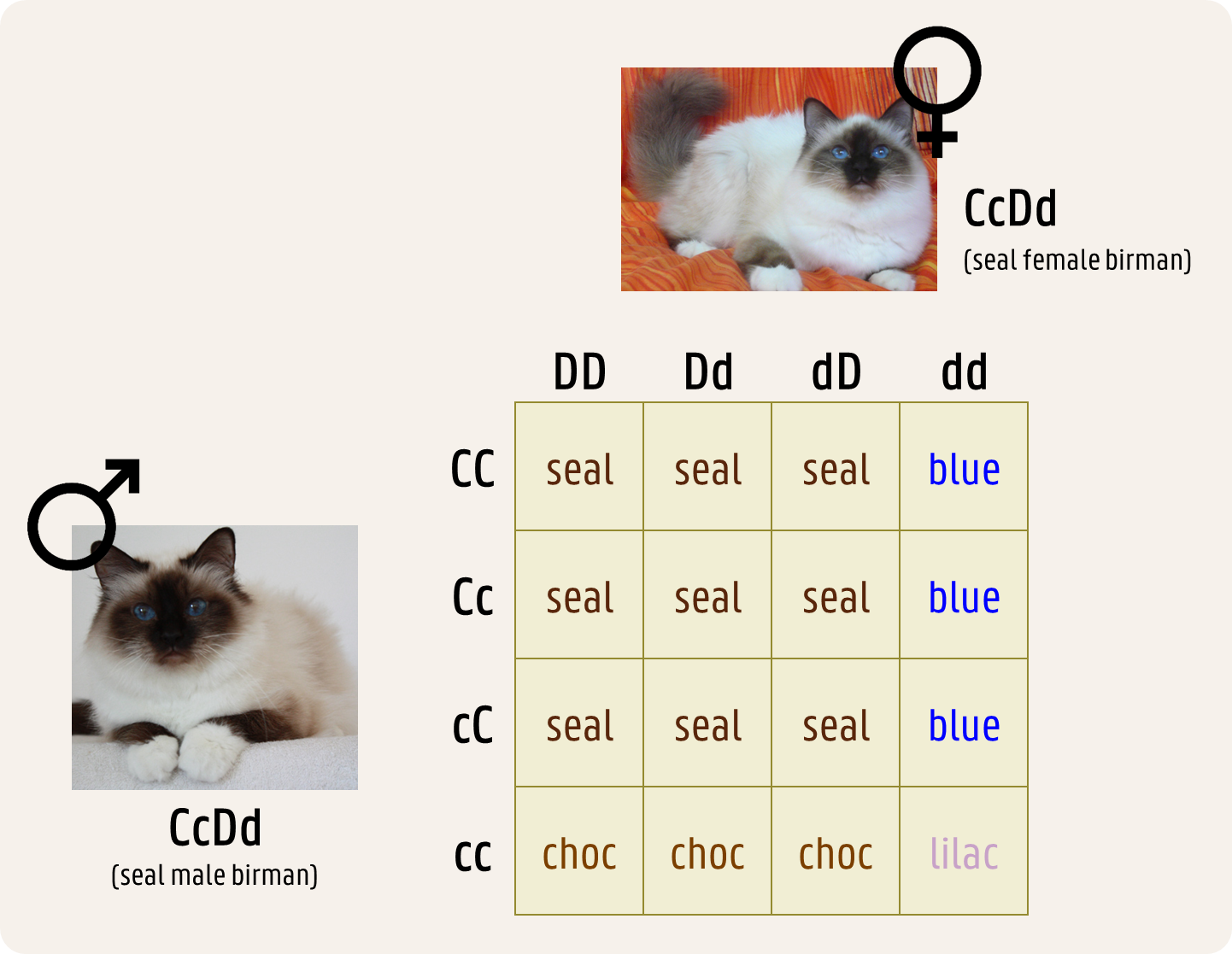
From this diagram we can derive that the first generation of kittens will have a distribution 9:3:3:1 of the point colors seal:chocolate:blue:lilac.
Assignment
We represent the genotype of a Birman by a string $$c_pc_md_pd_m$$ (str) of four letters, where $$c_p, c_m \in \{\texttt{C}, \texttt{c}\}$$ and $$d_p, d_m \in \{\texttt{D}, \texttt{d}\}$$. Your task:
-
Write a function color that takes the genotype (str) of a Birman. The function must return the point color (str) of the Birman: seal, chocolate, blue or lilac.
-
Write a function combinations that takes the genotype (str) of a Birman. The function must return the four possible combinations of C-genes and D-genes that the Birman may pass on to its offspring, listed in the generic order. This result must be represented as a list of 2-letter strings (str).
-
Write a function punnett that takes the genotypes (str) of a male and a female Birman. The function also has an optional third parameter pprint that takes a Boolean value (bool, default value: False). The function must return the Punnett square that contains the possible genotypes of the first generation kittens of the two cats whose genotypes are given. If the value False was passed to the parameter pprint, the result must be returned as a list of lists (list), where the inner lists represent the successive rows of the square. If the value True was passed to the parameter pprint, the result must be returned as a string (str), where the rows of the square are at separate lines and the genotypes on the same row are separated from each other by a single space.
-
Write a function color_distribution that takes the genotypes (str) of a male and a female Birman. The function must return a dictionary (dict) whose keys are the point colors (str) that may occur in the offspring of the two cats whose genotypes are given: seal, chocolate, blue and/or lilac. For each color that is used as a key in the dictionary, the associated value (int) must indicate how many of the 16 possible genotypes of the kittens result in that particular color.
Example
>>> color('CcDd')
'seal'
>>> color('ccdd')
'lilac'
>>> combinations('CcDd')
['CD', 'Cd', 'cD', 'cd']
>>> combinations('ccdd')
['cd', 'cd', 'cd', 'cd']
>>> punnett('CcDd', 'CcDd')
[['CCDD', 'CCDd', 'CcDD', 'CcDd'], ['CCdD', 'CCdd', 'CcdD', 'Ccdd'], ['cCDD', 'cCDd', 'ccDD', 'ccDd'], ['cCdD', 'cCdd', 'ccdD', 'ccdd']]
>>> print(punnett('CcDd', 'CcDd', pprint=True))
CCDD CCDd CcDD CcDd
CCdD CCdd CcdD Ccdd
cCDD cCDd ccDD ccDd
cCdD cCdd ccdD ccdd
>>> print(punnett('cCDd', 'CcdD', pprint=True))
cCDd cCDD ccDd ccDD
cCdd cCdD ccdd ccdD
CCDd CCDD CcDd CcDD
CCdd CCdD Ccdd CcdD
>>> color_distribution('CcDd', 'CcDd')
{'blue': 3, 'seal': 9, 'lilac': 1, 'chocolate': 3}
>>> color_distribution('cCDD', 'cCDD')
{'seal': 12, 'chocolate': 4}
>>> color_distribution('ccDD', 'ccDD')
{'chocolate': 16}
>>> color_distribution('ccdd', 'CcDd')
{'blue': 4, 'lilac': 4, 'seal': 4, 'chocolate': 4}Epilogue
While most cats have something mysterious about them (in the first place we think about the cat Winston Churchill from the 1983 Stephen King book Pet Semetary1), Birmans are one of few breeds that can boast their own legend.
The cats that live at the temple of Lao-Sun. A long time ago several groups of Kittah-priests lived in the mysterious land of Tibet. They adored the god Song-Hyo and the goddess Tsun Kyan-Kse. They built wonderful places to worship their gods: beautiful decorated temples covered with gold-leaf and surrounded by high walls for protection. These high walls offered protection to the priests and at the same time secured the hundred of white cats that were kept in each temple. The cats played an important role in the religion of the Kittah's: some of the priests had such pure souls that they couldn't be missed on earth. When they died the goddess transmitted the souls of the priests to the white cats.
Temple on mount Lugh. In a temple built on the mountain Lugh lived a priest called Mun-Ha. He was very religious so that it was said that the god Song-Hyo himself created the tresses in Mun-Ha's golden beard. Mun-Ha's thoughts were dedicated only to the god and the goddess of the soul-transmission: it was the goddess who decided which of the priests' souls were allowed to live again in the body of a sacred cat and it was she who decided when this soul was transmitted to another Kittah-priest. Tsun Kyan-Kse had sapphire eyes. The white cat Sinh who was always at the side of his master Mun-Ha had golden eyes — a reflection of his masters golden beard.In an evil night the temple was attacked by a band of murderous Phoums from Siam who killed Mun-Ha who was still meditating before the golden statue of the goddess. Until his last moment he gazed into the sapphire eyes of Tsun Kyan-Kse and then the miracle of the soul transmission took place: Sinh jumped on the head of his fallen master and continued to gaze into the eyes of the goddess. At that moment Sinh's eye color changed into sapphire just as radiant as the eyes of the goddess. His white fur changed into a dark color at the extremities of his body and a dark mask appeared on his face. The rest of his body took on a golden color except for his feet: they turned white at the spots where his feet touched the hair of the old priest. Only once Sinh turned his head towards the huge temple gate and the Kittah-priests managed to close the gate so that further ransacking was stopped.
For seven days and nights Sinh remained seated there and gazed into the goddesses' eyes, neither eating nor drinking. He died on the seventh day taking Mun-Ha's soul to Tsun Kyan-Kse. It was seven days later when the Kittah-priests collected around the statue of the goddess to decide who would become the successor of Mun-Ha. All the temple cats appeared and all of them had Sinh's coloring pattern. In utter silence the cats grouped themselves around the youngest of the Kittah-priests and thus the goddess choose Mun-Ha's successor.
This is the legend of the Sacred Birman Cat: they have the brilliant blue eyes of the goddess, the golden hue that reflected from both their master and the golden statue of the goddess and with dark brown as a symbol of the impurity of the earth: the wicked murder of the priest but with white feet as a symbol of the purity of the soul.
